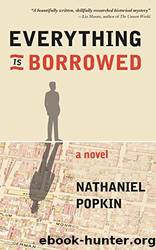Everything Is Borrowed by Nathaniel Popkin

Author:Nathaniel Popkin [Popkin, Nathaniel]
Language: eng
Format: epub
Tags: fiction
Publisher: New Door Books
Published: 2018-07-14T22:00:00+00:00
21
On October 16, the day Prenner, Gillis, Jacobs, and Moskowitz appear before Judge Biddle, the clerk enters his name in the court docket, âJulius Moskowitz.â The clerk has placed a check next to the name of each defendant. He notes the men were kept at County Prison, a crenelated fortress just south of the Jewish quarter. After the hearing, another clerk, writing in a coarse and dark hand, notes, âLoui Jacobs and Julius Moskowitz remanded.â Fingerprints in red-brown smudge, a result of the deteriorating leather binding, crowd the edge of the page, like the muddy water of a receded flood. The clerk has added an additional hash mark next to Moskowitzâs name. Is this to say he appears doubly guilty? But on further inspection, the extra line is the cross of the t in Moskowitz. The line has gone astray.
âIâm no longer seeking answers,â I say in a whisper. No one in the archives seems to hear. Am I talking to Nadia or Eva?
Moskowitz, do you feel like youâre wrongly accused?
Brother, are you scared? Did Biddle frighten? Does Judge Arnold intimidate?
Can you follow the court proceedings?
Do you feel an urge to tear the courtroom down?
Have you noticed the great girth of the prison?
Friday, January 8, 1892. The case of Moskowitz is the fifth of the day in the courtroom of Judge Michael Arnold. October to January, Moskowitz is in County Prison for almost three months. County Prison is also called Moyamensing Prison. You can find an 1838 engraving of the prison on the Internet. The engraving is by the artist J. C. Wild, from his book Panorama and Views of Philadelphia and Its Vicinity. Thomas Ustick Walter, who will build the new addition to the U.S. Capitol in Washington, D.C., designs the prison with gothic turrets and battlements, a castle of the dispossessed. Walter, who is of Scottish descent, must be drawing on a memory. Two horses pull a carriage down the Passyunk Road (as it is called then); two boys play along the wall of the stone fortress. The enormous prison dominates the landscape that defines their world. Yet the skill of the architect renders it human to the passersby. It must be imprinted on the memory of thousands of neighbors, still. Wild, the artist, bathes the prison in southern light and one of the boys casts a shadow along the base of the wall. The shadow takes the shape of a rattlesnake half upright, as if on alert.
The prison is a flight of visual fancy. The Temple of Amenhotep III, on the Nile, inspires Walterâs design of the debtorsâ section. What possesses the architectâs mind? Amenhotep III is the artist of the desert. He dresses Egypt in statuary. He delights in the colossal. Even in the land of the pyramids, his mortuary temple explodes the imagination. Floods gnaw at it for two hundred years, leaving it in ruins. Walter takes a nibble for Philadelphia. Is this an act of resurrection? I look again at the engraving by J.
Download
This site does not store any files on its server. We only index and link to content provided by other sites. Please contact the content providers to delete copyright contents if any and email us, we'll remove relevant links or contents immediately.
| African | Asian |
| Australia & Oceania | Canadian |
| Caribbean & Latin American | European |
| Jewish | Middle Eastern |
| Russian |
The Hating Game by Sally Thorne(19112)
The Universe of Us by Lang Leav(15006)
Sad Girls by Lang Leav(14311)
The Lover by Duras Marguerite(7820)
The Rosie Project by Graeme Simsion(6185)
Smoke & Mirrors by Michael Faudet(6129)
Big Little Lies by Liane Moriarty(5699)
The Shadow Of The Wind by Carlos Ruiz Zafón(5638)
The Poppy War by R. F. Kuang(5566)
An Echo of Things to Come by James Islington(4751)
Memories by Lang Leav(4748)
What Alice Forgot by Liane Moriarty(4566)
From Sand and Ash by Amy Harmon(4386)
The Poetry of Pablo Neruda by Pablo Neruda(4038)
The Tattooist of Auschwitz by Heather Morris(3792)
Ficciones by Jorge Luis Borges(3569)
Guild Hunters Novels 1-4 by Nalini Singh(3406)
The Rosie Effect by Graeme Simsion(3372)
THE ONE YOU CANNOT HAVE by Shenoy Preeti(3291)
